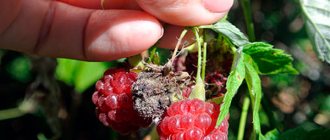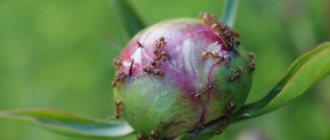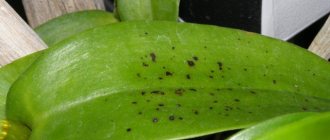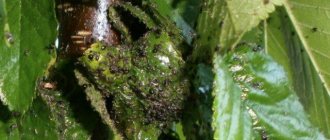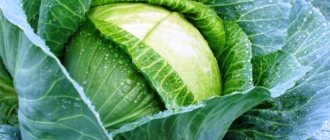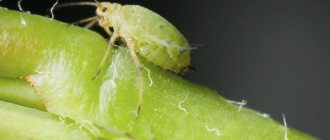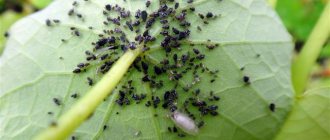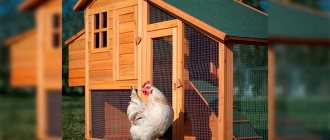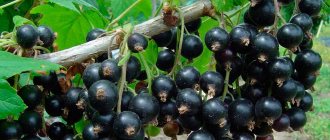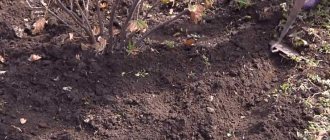Aphids are a real disaster for summer cottages. It causes enormous damage to plants, sucks out juices, and leaves wounds on the leaves through which viruses penetrate. In addition, aphids deform leaves, eat young shoots, and destroy flower ovaries, reducing the yield.
Ants that crawl along currant branches feed on aphids. In search of nectar, they climb into the inflorescences, preventing the berry from forming. They transmit fungi and viruses to the plant. Ants, building anthills under a currant bush, dig through underground passages and damage the roots of the plant. In addition to currants, aphids also attack other plants, infecting the entire garden.
Types of aphids that harm red currants
Red currants are attacked by two types of aphids: shoot and leaf (gall). In addition to the fact that it differs in appearance, the methods of dealing with it are also different.
Shoot aphid
This species is found on gooseberries and black currants, as well as apple trees, plums, and pears. The peak of its reproduction is May-June, when young succulent shoots appear on bushes and trees. Shoot aphids look like small bugs with an ovoid body of light green color.
During the season, 8-12 generations of shoot aphids are replaced. Damage to the plant is caused by larvae and females. They stick to young succulent shoots, take away all the juices, causing the leaves to curl. They form dense cocoons, inside which a colony of parasites settles. As the colony grows, it looks for new places for parasitism and attacks fresh shoots. If measures are not taken in time, the currants will dry out and die.
Shoot aphid
Work on eliminating shoot aphids should begin with the first thaw. Starting from mid-February, daytime temperatures become above zero. During this period, fertilized eggs laid at the base of the kidneys awaken. The larvae are distributed throughout the kidney, feeding on juices. It can be immediately noticed: it is larger than healthy kidneys, deformed and dry to the touch. On bare branches it is most convenient to carry out the first preventive measures to destroy shoot aphids.
Gall (leaf) aphid
Gall aphids differ in appearance from shoot aphids. Its bugs have not a smooth, but a terry surface. If zoomed in, it would be clear that their body is covered with hairs. It settles not on young shoots, but on the underside of the leaf. Her principle of sabotage is also somewhat different. If the shoot aphid feeds on plant juices, the gall aphid makes a puncture on the surface through which it feeds and leaves waste products. A growth called a gall forms on the leaf. If you turn it over, you can see a colony of gall aphids under the leaf. Other viruses and microorganisms enter the injection hole, causing the plant to die. The peak breeding season for gall aphids is June. At the end of July, when the foliage becomes coarser, the aphids lay eggs, which live not in the buds, but under the bark. They mature for 250 days, i.e. approximately 9 months. If the eggs are not destroyed in time, several hundred individuals will form in their place in May. Unlike shoot aphids, gall aphids migrate to other plants and trees at the end of July. This type of pest mainly attacks red currants because their foliage is more delicate compared to black currants.
Appearance of gall aphids
Gall formed on a currant leaf
Description of the pest
Aphids are homoptera or wingless parasitic insects that settle in colonies on green plants. It feeds on the sap of young shoots and transmits plant disease viruses. If the leaves of the pepper turn black and the buds fall off, then the number of insects has reached catastrophic proportions. You can find the insect on the back of a green leaf.
Learn how to control slugs and caterpillars on peppers. External signs:
- oblong or drop-shaped body;
- size - from 3 to 8 mm;
- the body is soft, transparent, its color depends on the color of the plant on which the insect parasitizes;
- the head is trapezoidal, the organs of hearing and touch are located on the jointed antennae located on the forehead;
- the eyes are colored red, brown, black, insects have excellent vision;
- the legs are thin, long, have walking and jumping functions;
- oral apparatus in the form of a proboscis capable of piercing the surface of a green leaf or stem;
- the abdomen consists of 9 segments, the last of which is underdeveloped, in the shape of a tail;
- the body is covered with fluff of varying lengths.
Did you know? Ants guard aphid colonies by feeding on their sweet honeydew. For the winter, they roll insect eggs into an anthill. to save the colony from extinction.
Natural remedies for treating currants against aphids
Treatment with insecticides is not always safe, especially if there are hives near the summer cottage. In addition, during late processing, the particles of the drug do not have time to wash off and remain on the berries. In this case, natural means of pest control are needed.
Laundry soap
An excellent remedy in the fight against shoot aphids. The principle of operation is simple: aphid bugs are covered with a waxy shell, and soap is an alkali that destroys it. In addition, the main active component of soap, caproic acid, is an antibiotic. The most effective is 72% soap, which is grated or cut into slices with a knife, pour 1 liter of water per 100 g of soap and infuse until completely dissolved. Before spraying, the workpiece is mixed with 9 liters of water, resulting in 10 liters of solution. To increase efficiency, add 100-200 g of vegetable oil, which is less easily washed off by rain. You need to process both the upper and lower parts of the leaves, as well as the inflorescences.
Other means
Liquid tar soap is also suitable, but in proportions of 125 ml per 10 liters of water. Cosmetic soap cannot be used. There is an option of spraying with a solution of tobacco dust and hot pepper. But there is a significant drawback - irritation of the human respiratory tract. And, unlike a soap solution, the effectiveness of tobacco-pepper spraying decreases after rain.
Another important condition: spraying with laundry soap is effective only in May, when aphids have not formed huge colonies. In June-July it is better to use special preparations.
Pests in a greenhouse or in open ground
Most pests live both in the greenhouse and in open ground. However, whiteflies, Colorado potato beetles and mole crickets are most often found in structures.
They appear there due to a special microclimate: high humidity and heat. The mole cricket is a powerful insect with a shell about 5-8 cm long.
The pest has a forked tail and large wings. The mole cricket eats the underground part of the pepper.
Open ground is characterized by aphids and spider mites. They arise due to frost, waterlogging of the soil or excess fertilizing. To prevent the appearance of pests, gardeners take a number of preventive and therapeutic measures.
Plants susceptible to aphid damage
It should be noted that there is no particular difference between the methods of destroying shoot and gall aphids. It also does not matter what drug to treat this or that plant. The only difference is in the dosage, but instructions are usually included with the drug. It also happens that, no matter how you treat the bushes, aphids appear on it again soon. And all because there are plants that are especially attractive to the pest. These include:
- viburnum. This medicinal plant blooms quite early, attracting aphids awakened after winter with its young leaves. Therefore, before you start processing red currants, you need to process viburnum;
- Apple tree. This applies to young trees with tender, succulent shoots. Aphids especially harm petioles, which dry out and fall off. If you do not treat the tree, the colony of pests will spread throughout the garden;
- roses. Aphids love buds and shoot ends;
- peppers. Aphids cover green leaf blades and ovaries with a continuous carpet, which is why almost the entire harvest is lost;
- cabbage. Its succulent leaves are especially attractive to aphids. As a result, the cabbage turns yellow and a normal head of cabbage does not form;
- cucumbers Their fresh greens seem especially attractive to aphids. She also does not disdain young ovaries. Timely spraying will help save the crop;
- loves aphids and flowers, especially nasturtium. Sometimes it is recommended to plant it next to currants as a bait plant. It is much easier to destroy several colonies by tearing out a flower than to wage a painstaking fight on a large bush.
Signs of appearance
It is especially noticeable that the aphids attacked the blackcurrant bush. As a rule, at the tops of the shoots the leaves curl into cocoons. The leaves curl towards the bottom and inwards. The ovary simply resembles a lump of greenery, inside of which lives a whole colony of insects.
See also How to properly care for currants in the fall
On red currants, as a rule, when attacked by aphids, red tubercles and swellings appear on the foliage. The branches also become reddish, and growths appear on them.
Currant bushes have green foliage very early in the spring, making the bushes a prime target for aphids. In the summer, you can understand that parasites have appeared on currants by lagging plants in growth, as well as by a sharp decrease in yield.
How to get rid of aphids on currants - useful video
This video describes an effective method of treating currants against aphids, which allows you to get rid of the pest before the end of the season. We advise all gardeners and gardeners to watch it!
I noticed that the treatment needs to be carried out comprehensively, i.e. simultaneously process currants, gooseberries, apple trees, pears, plums, viburnum and other trees and shrubs. The main thing is to do everything on time. It is imperative to pluck off damaged leaves and shoots if it is not possible to spray the bushes with a stream of water a few days after treatment. Currants are responsive to care, and, having received protection and care, will delight you with a good harvest in any weather conditions.
Prevention measures
To protect currant bushes, it is necessary to systematically prevent the appearance of pests.
You cannot plant currants next to linden and viburnum, since aphids prefer to settle on them. The soil around the bushes must be loosened regularly.
Pruning in spring and autumn is recommended so that the crown of the bushes is not thickened. To protect shrubs, plants that repel insects should be planted nearby. Before harvesting, it is necessary to carefully inspect the plantation in order to notice pests in time.
Champagne made from birch sap
Birch sap is a good base for making homemade champagne, a light and invigorating drink.
You will need 12 liters of birch sap, 2-3 kg of sugar, 1 tsp. citric acid, 50 g liquid honey; for sourdough: 100 g raisins, 25 g sugar, 1 glass of water.
Preparation. First prepare the starter. To do this, mix unwashed raisins, sugar and water and leave to ferment at room temperature for 3-4 days. Then strain the juice into a saucepan, add 2 kg of sugar and citric acid, bring to the boil and simmer until the liquid has reduced by about 15%.
Cool the mixture to room temperature, add the prepared starter and honey. Stir, pour the mixture into a bottle, close with a water seal and place in a warm place to ferment.
When fermentation ends (after 20-40 days), strain the liquid into a clean container, removing any sediment. Pour sugar into clean plastic bottles (at the rate of 10 g per 1 liter of liquid), pour in wine, seal and leave for 7-10 days in a dark room at room temperature. During this time, check the gas level in the bottles: if the bottle is hard, open the lid slightly and release the gas.
Then place the bottles of champagne in the cellar or refrigerator and keep for another 2-4 days. Store the finished drink in the cellar or refrigerator for six months.
Advantages and disadvantages of traditional methods of combating aphids
When choosing between chemical and traditional methods of destroying aphid colonies, you need to clearly understand both the advantages and disadvantages of home remedies:
| Benefits of folk remedies | Disadvantages of folk remedies |
|
|
Thus, if there are few aphids in the greenhouse, and only individual peppers are affected, home remedies can help cope with this problem. Otherwise, it is better not to waste time and buy a chemical insecticide.
“Although gardeners are often afraid to use chemical protection products, sometimes they cannot do without them. In particularly unfavorable years, aphids reproduce so actively that one has to choose between environmental safety and complete loss of the harvest. But here you need to understand: modern insecticides, if you use them correctly and observe the waiting periods, will not cause much harm to the ecology of the site and human health.”
L. Dobryakova, agronomist
